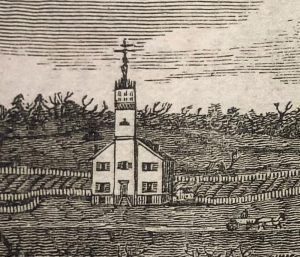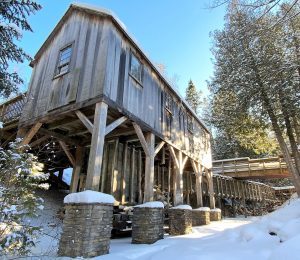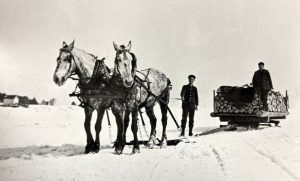
In October 1796, Major Henry Burbeck, the first American commander of Fort Mackinac, estimated the lumber required for repairing and upgrading the fort’s palisades and buildings. Among the planks, boards, pickets, shingles, and scantling, his estimate included 1,420 logs measuring 20 feet long by 15 inches in diameter. If they were white pine (one of the lighter species), this single portion of his order would have weighed over 1,249,000 pounds, or nearly 625 tons.
To transport such heavy loads, logs were often stacked on stout sleds and skidded over ice, pulled by oxen or horses. For many years, turning logs into boards at the Straits of Mackinac was either done by hand with a pit (whip) saw or at a water-powered sawmill which operated at Mill Creek from 1790-1839. Originally constructed by Robert Campbell, the mill was purchased in 1819 by Mackinac Island businessman Michael Dousman. Both owners filled lumber contracts for Fort Mackinac and other island projects. The following account recalls events that took place nearly two centuries ago, in early 1830.
The Carpenter-Schoolmaster

Martin Heydenburk came to Michigan in 1824 after accepting a teaching position at the Mission School on Mackinac Island. Also an experienced carpenter, his skills as a craftsman were utilized for construction of the Mission House, completed in 1825. During the winter of 1829-1830, Heydenburk was called upon to lead a crew in felling and cutting timber on the mainland for building a Protestant church for the mission. Today, Mission Church is Michigan’s oldest surviving church building.

In early 1830, solid ice didn’t form in the Straits of Mackinac until the end of January. In February or early March, Heydenburk and his crew spent several cold weeks along the Lake Huron shoreline. He later recalled, “in three weeks’ time we had all the timber hewed, fifty pieces flattened to be made into scantling and joist with the whip-saw, and three hundred saw-logs hauled out of the woods to the shore ready to be moved home or to the saw mill when the ice should prove favourable. A few weeks afterward a heavy rain flooded the snow upon the ice and then froze. Michael Dousman had a saw-mill about two miles from our logs and we soon had them there …”
French Trains to Mackinac Island
Heavy rain proved to be a mixed blessing for the timber project. After it refroze, the flooded lakeshore offered a smooth surface to haul logs to the sawmill. Rainwater also filled the creek and mill pond, providing an ample supply of water power to cut 300 logs into boards. Once the order was completed, word was sent to Mackinac Island and horse-drawn sledges were sent over the ice to pick up lumber from the sawmill.

Heydenburk continued, “On the eleventh day of April, with the thermometer at zero, and the wind blowing strong from the east, all the horses and French trains on the Island started at daylight for the timber; we crossed safely, loaded up and started for home.” A French train was a narrow, deep box sleigh, pulled by one or two horses, which slipped easily over ice and snow. Dogsleds were also used for winter mail and hauling smaller loads to Mackinac Island. Sleighs and sledges were used well into the 20th century for hauling goods such as hay, groceries, and firewood from the mainland or nearby Bois Blanc Island.
As they trudged along hauling heavy loads of lumber, news reached the teams that rain had degraded the ice, making the journey unsafe. Heydenburk recalled, “when about half way across the straits we were met by messengers and guides who told us that the ice which was two feet thick had become porous and we could not cross the channel. We left our loads on Round Island, then put rope on the necks of the horses and started across the treacherous channel … We all got home safe.” Thankfully, such dangerous spring journeys are now but distant memories at the Straits of Mackinac.









